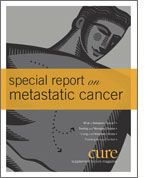Publication
Article
CURE
The Molecular Revolution
Author(s):
Molecular and genomic information can identify tumors most likely to respond to a specific drug.
A common theme running through recent advances for metastatic cancers has been the increasing role of molecular or genomic information to identify tumors that are most likely to respond to a specific drug and to develop drugs that target specific cellular pathways.
For example, identification of the BCR-ABL mutation in chronic myeloid leukemia led to the development of effective drugs that turned a highly fatal cancer into one with survival times of 20 years and more. In colorectal cancer, the mutation status of the KRAS gene is being used to identify patients who are candidates for EGFR-targeted antibodies, while EGFR mutations may be used to select therapies in lung cancer. Overexpression of the estrogen receptor and HER2 can be used to determine treatments for patients with breast cancer. More recently, new agents have been developed for lung cancers with a rearrangement of the ALK gene and for melanomas that contain a BRAF mutation.
We use the information to assign the patients to the treatments, but we also use the tissue and material to potentially discover new things that could benefit future patients with lung cancer.
Molecular information is also beginning to drive the design of clinical trials to develop new therapies. One such trial is the BATTLE-2 lung cancer trial, a study “designed to understand how tissue biomarkers predict who will respond to targeted therapy or targeted therapy combinations,” according to Yale School of Medicine’s Roy Herbst, MD, PhD, one of the lead investigators. Patients entering the trial undergo a biopsy, the genetic status of their tumor is determined, and they are assigned to one of four different drugs or combinations. As the trial goes on and researchers learn about the predictive power of different biomarkers, this information will be used to help select the treatment that patients receive.
“We use the information to assign the patients to the treatments, but we also use the tissue and material to potentially discover new things that could benefit future patients with lung cancer,” says another lead investigator, Ignacio Wistuba, MD, of M.D. Anderson Cancer Center in Houston.
As researchers continue to mine the molecular make-up of cancers cells, patients can look forward to more effective treatments tailored specifically for them—and that’s a revolution to believe in.






